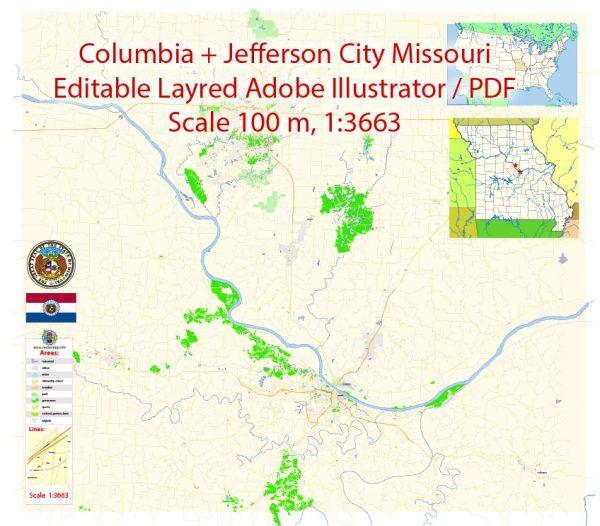Columbia and Jefferson City, both located in the state of Missouri, have distinct histories of urban development that reflect the broader trends in American history.
Columbia:
Early History:
- Columbia was founded in 1821 and was selected as the site for the University of Missouri, the state’s flagship university.
- The city’s location was chosen because it was roughly equidistant from the Missouri and Osage Rivers, providing a central and accessible location.
Role of Education:
- The presence of the University of Missouri has been a significant factor in Columbia’s growth and development.
- Over the years, the city has evolved into a hub for education, research, and cultural activities.
Economic Development:
- Columbia has seen steady economic growth, partly due to its educational institutions, healthcare facilities, and diverse economy.
- The city has attracted various industries, including healthcare, insurance, and technology.
Urban Expansion:
- Columbia has experienced urban sprawl and expansion over the years, with new residential and commercial developments extending the city’s boundaries.
Jefferson City:
Capital City:
- Jefferson City, the state capital of Missouri, was selected as the capital in 1821, the same year as Columbia’s founding.
- Its location along the Missouri River played a crucial role in its selection as the state’s capital.
Government and Administration:
- The presence of state government institutions has been a driving force behind Jefferson City’s development.
- Government offices, including the Missouri State Capitol, contribute to the city’s economic and social fabric.
Historical Significance:
- Jefferson City has preserved many historic buildings and sites, providing a glimpse into Missouri’s history.
- The Missouri State Penitentiary, now closed, is an example of a historic site that draws attention to the city’s past.
Riverfront Development:
- The Missouri River has influenced the city’s development, and efforts have been made to revitalize the riverfront area for recreational and economic purposes.
Common Themes:
Transportation:
- Both cities have been shaped by their proximity to rivers and the role of waterways in transportation and commerce.
- The development of railroads and later highways further influenced the growth and connectivity of Columbia and Jefferson City.
Cultural and Educational Influence:
- The presence of universities and government institutions in both cities has led to a diverse cultural scene and a steady influx of residents.
Modern Challenges:
- Like many American cities, both Columbia and Jefferson City face challenges related to urbanization, infrastructure, and maintaining a balance between growth and preservation.
Understanding the history of Columbia and Jefferson City provides insights into the broader trends in American urban development, showcasing the impact of education, government, and transportation on shaping these cities over time.


 Author: Kirill Shrayber, Ph.D.
Author: Kirill Shrayber, Ph.D.